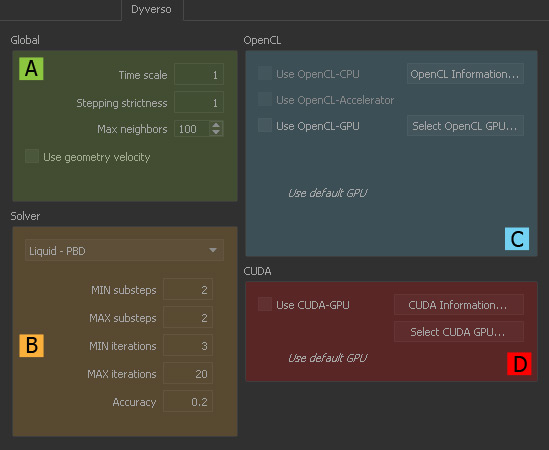Dyverso Tab
To change the parameters of this tab on a global level use the → "Preferences - Simulation: Dyverso" dialogue.
Jump to
Global (A)
Time scale
Values smaller than 1.0 will decelerate the fluid; settings greater than 1.0 have an acceleration effect. “Time scale” works as a factor: 2.0 means that the fluid will be two times faster.
Stepping Strictness
RealFlow calculates how fast the fluid will move within a substep:
- With a value of 1.0, the fluid will not move more than the distance of 1 particle diameter in the current time step.
- With values smaller than 1.0, the fluid can cover a longer distance within a single step – the solver is less strict.
Max neighbors
This parameter is only relevant for → GPU simulations. Dyverso looks for neighbours to create the links and constraints between them. By default, 100 particles will be taken into consideration:
- The less neighbours, the faster the simulation, but you might see stability problems.
- We recommend using the pre-adjusted value.
Use Geometry Velocity
When enabled RealFlow will adjust the simulation's substeps to get a correct fluid-object interaction behaviour:
Imagine an object falling into a container with calm water.
Here, RealFlow uses very large substeps to speed up the simulation.
Due to these large steps the interaction between the object and the fluid is delayed.
With “Use Geometry Velocity” the interaction will happen in time again.
Solver (B)
Here you change the default simulation settings for all Dyverso fluid types. The parameters are exactly the same for all fluid types except "Dumb". Browse through the tabs and choose an entry:
MIN substeps
Specify the minimum number of simulation steps for Dyverso fluids:
- Higher values increase simulation time but also maybe lead to instabilities. We recommend moderate increases of just a few substeps.
- For a fixed number of substeps use equal values for “MIN substeps” and “MAX substeps”.
- The default value normally provides the best ratio between speed and accuracy.
MAX substeps
Specify the maximum number of simulation steps for Dyverso fluids:
- Higher values increase simulation time but also maybe lead to instabilities. Try using values around the default setting.
- For a fixed number of substeps use equal values for “MIN substeps” and “MAX substeps”.
- The default value normally provides the best ratio between speed and accuracy.
(MIN) iterations ("MIN" only for "Liquid - PBD", not for "Dumb")
Specify the minimum number of simulation cycles:
- Higher values increase simulation time, but also avoid instabilities.
- For a fixed number of iterations use equal values for “MIN iterations” and “MAX iterations”.
MAX iterations (only for "Liquid - PBD")
Specify the maximum number of simulation cycles:
- Higher values increase simulation time, but also avoid instabilities.
- For a fixed number of iterations use equal values for “MIN iterations” and “MAX iterations”.
Accuracy (only for "Liquid - PBD")
This parameter ranges between 0.0 and 1.0. With
- 0.0 RealFlow quickly finds a solution, but it will not be very accurate
- 1.0 RealFlow finds a solution that is very close to the exact behaviour, but simulation time will increase.
OpenCL (C)
Due to the almost infinite number of hardware combinations we cannot guarantee that RealFlow's OpenCL features are available for any computer or graphic device. Please read the → "GPU" chapter if you encounter performance issues.
Use OpenCL-CPU
This option is only available if your computer supports OpenGL-CPU calculations.
Use OpenCL-GPU
You can activate this option if your graphics card has OpenCL capability, otherwise it is greyed out.
Use OpenCL-Accelerator
This function is only available with dedicated OpenCL-acceleration hardware. These devices have to be purchased separately.
System Information...
Open a comprehensive summary about your GPU's features and capabilities.
Select GPU...
Got more than one GPU in your computer? Choose here which board you want to use with your Dyverso simulation.
CUDA (D)
Please read the → "GPU" chapter if you encounter performance issues.
Use OpenCL-CUDA
You can activate this option if your graphics card has CUDA capability, otherwise it is greyed out.
CUDA Information...
Open a comprehensive summary about your GPU's CUDA features and capabilities.
Select CUDA GPU...
Got more than one CUDA GPU in your computer? Choose here which board you want to use with your Dyverso simulations.
